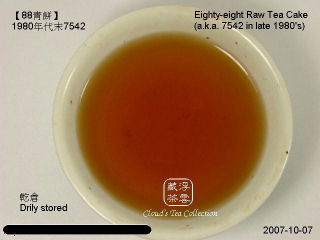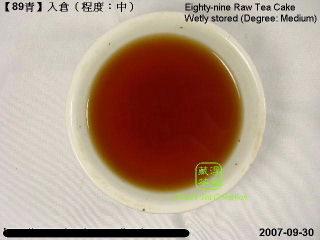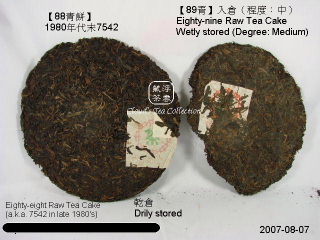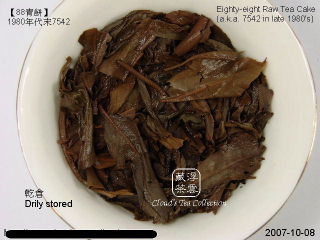
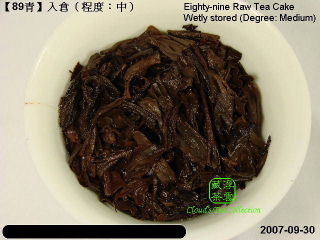
The last Cloud's Tea Diary discussed about "What are Dry Storage and Wet Storage?" In this diary, Cloud will talk about how to tell the differences between the tea cakes of dry storage and wet storage.
The Reason for Wet Storage
For teas other than Puerh, consumers normally know that tea leaves are vulnerable to moisture. Thus, preserving tea leaves out of dampness is the basic concept of storing tea at home. Unfortunately, it is not the case for Puerh tea. That's why Puerh tea novices may have these questions, "Do I need to seal up the Puerh?" or "Do I need to put Puerh tea into a fridge?"
Raw Puerh tea is a very special kind of tea. It needs further fermentation (or someone may name this process as "oxidization"). In any case, it means Puerh tea needs time to age after it comes out from the tea factory. If a piece of Puerh tea cake is sealed up in a plastic bag or put into a fridge, it will not change or age even though it might have been stored for more than 10 years.
Several decades ago, Hong Kong was still developing her economy. It was impossible for tea shops to sell their first tea cake after 20 years of storage. It was also impossible for them to sell raw tea cake (green taste) at that time because Hong Kong tea consumers did not accept such a raw and astringent taste. Besides, there was no concept of self-storing Puerh 20 years ago. As a result of these marketing backgrounds, raw tea cakes were hard to sell at that time. Hong Kong tea traders had to do something to make the raw tea cakes mellower in order to get a quick sale within several years. These tea traders accidentally discovered that high humidity could help Puerh tea change to a better and aged taste. Therefore, they used some artificial methods (normally releasing huge amount of steam) to raise the dampness of the storing environment in order to make a wet storage.
Is the Absolute Dry Puerh the Best?
Around year 2000, some suggested that Puerh tea should be stored in a very dry place. Owing to the mis-unstanding of the true meaning of "DRY", these people stored their Puerh tea in an almost absolutely dry environment. After 10 years of storing, they realized that the aging progress was much slower than their expectation.
This experience tells them that Puerh tea needs certain level of humidity. That is the reason why "Natural Storage", which means moderate wet and dry, has been promoted in recent years. However, this "natural" only applies to certain tea storing areas having natural four seasons, for examples, Hong Kong, Macau and some Guangdong areas. The distinctive four seasons give a positive life cycle for Puerh tea to age.
How to Distinguish Between Dry Storage and Wet Storage
The following table shows the characteristics and differences between Dry Storage and Wet Storage. Please click Photo A0410 and compare the tea cakes carefully:
| Dry Storage Photo A0410 (Left) | Wet Storage Photo A0410 (Right) | |
| Tea Cake | Clean, shiny, not dull, sharp dry tea leaves, fresh aroma (Photo A0407) | Dull, not shiny, little bit white substance on tea leaves, brown if medium to seriously wet, blurry tea leaves, slightly rotten smell if no revivifying (Photo A0603) |
| Tea Broth | Light to medium chestnut red, clear and shiny (Photo A0423) | Deep chestnut red, unclear, even dark tea broth if it is seriously wet storage (Photo A0415) |
| Brewed Tea Leaves | Vivid, soft, elastic, light chestnut red with light greenish color, no ossified tea leaves (Photo A0424) | Generally deep chestnut red, low elasticity, uneven color of tea leaves, lots of ossified tea leaves if it is seriously wet storage (Photo A0416) |
12 January 2009 wrote in Chinese
11 December 2010 translated into English
Cloud (Hong Kong)
Back to: By Category reading mode
Cloud's Tea Diary
http://www.cloudsteacollection.com/html/weblog/weblog_e.html
Cloud's Tea Collection - Private Tea Album
http://www.cloudsteacollection.com
